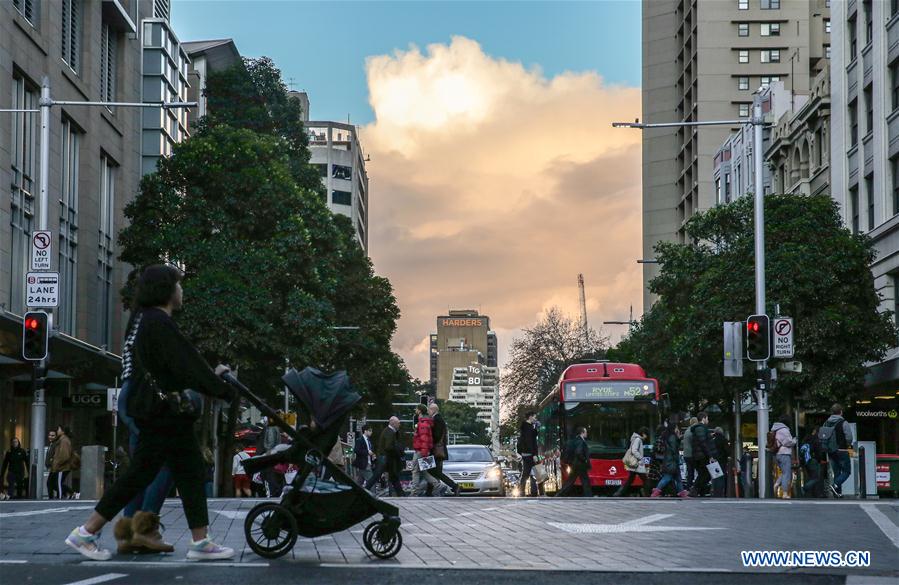
Pedestrians walk on a street in Sydney, Australia, on June 24, 2020. Australia's response to the COVID-19 pandemic has been among the most successful in the world, going from 400 cases a day at the peak of the outbreak to just a handful of new cases a week, but the country may now stand on the brink of a second mass outbreak. (Xinhua/Bai Xuefei)
by Duncan Murray
SYDNEY, June 24 (Xinhua) -- Australia's response to the COVID-19 pandemic has been among the most successful in the world, going from 400 cases a day at the peak of the outbreak to just a handful of new cases a week, but the country may now stand on the brink of a second mass outbreak.
Since the crisis began, Australia has officially reported around 7,400 cases, far fewer than many other countries thanks to a rapid shutdown of travel, unessential businesses and the mandatory quarantine of international arrivals.
However several clusters of COVID-19 which appeared last week in the state of Victoria have seen the daily case rate shoot back into the double digits and put the entire country on heightened alert.
On Wednesday, Australia recorded its first virus-related death in more than a month, that of a man in his 80s who passed away in Victoria, taking the national death toll to 103.
Following the death, Victorian Premier Daniel Andrews called for assistance from the Australian Defence Force to help contain the virus and deal with rapid, widespread testing in his state.
The unfortunate developments are further evidence that Australia has not yet won the battle against COVID-19 and risks a second wave of infections as it eases containment measures, according to Prof. Stephen Duckett, director of the Health Program at Grattan Institute and Emeritus Professor of Health Policy at La Trobe University.
Duckett told Xinhua on Wednesday that Victoria's outbreak does not yet constitute a second wave, but what may cause one is a sense of complacency which quickly crept in as case numbers dropped.
"We see that the numbers are really really low and so we think that the risk of getting infected is really really low," Duckett said.
"So we're going out shopping in the way we used to, we're going to indoor parties and not social distancing, and this relaxing of our guard has created the conditions for the virus to spread again."
In retrospect, Duckett adds that the easing of government mandated social distancing measures in Victoria may have been premature.
"It's easy with hindsight to say it was a bit early, but there was a lot of pressure obviously on the government to lift restrictions. It looked good, the virus was right down low in terms of numbers, so it's unfortunate."
In response to the outbreak Victorian health officials lowered a 20 person limit on household gatherings to five people, and postponed a further easing of restrictions for bars and restaurants.
On Wednesday major supermarkets in Victoria reintroduced purchase limits on certain products including toilet paper and hand sanitizer, after recording a surge in demand across parts of state capital Melbourne.
All this comes as a harsh flashback to the very beginning of the pandemic for Victorians, made even harder to swallow considering the new-found freedoms being enjoyed in other parts of Australia.
For roughly 60 percent of the population the virus remains under control, with most regions recording zero new cases for an extended period, and even Victoria's neighbor state of New South Wales (NSW) effectively slashing community transmissions.
Starting this weekend the state of Western Australia (WA) will enter phase four of easing virus restrictions, removing limits on public gatherings, which will see sports crowds of up to 30,000 people along with a one person per two square meter rule for hospitality venues, compared to four square meters in the rest of the country.
With that enviable level of freedom potentially at risk, Duckett says that he is opposed to the much discussed prospect of reopening state borders, despite the potential benefit to struggling tourism operators.
"If I were in WA, I would not want to reopen the border until it's safe," he said.
"And I think safe will mean zero cases in Victoria for a couple of weeks, because otherwise there is a risk that someone from Victoria will take the infection with them to WA and then they have to start all over again."
Even neighboring NSW, which has maintained open borders with Victoria throughout the pandemic, warned its citizens not to travel to the state.
"We've suggested to Sydneysiders to rethink any travel to Melbourne whatsoever, so we're recommending people just don't travel to Melbourne at this time," NSW Premier Gladys Berejiklian told national broadcaster the ABC on Wednesday.
In terms of its international borders, Australia appears likely to remain closed until at least 2021, with Federal Health Minister Greg Hunt suggesting it may take until an effective vaccine is available.
In the meantime, the mandatory quarantine of those granted an exception to travel to Australia remains an effective defence according to most.
Locally, beleaguered state leaders and health officials are hoping that the outbreak in Victoria will serve as a practical warning to all Australians, this is not over.
"There will be community spikes, community outbreaks during the course of the pandemic," Berejiklian said.
"It's a good wake-up call to remind us about how contagious the disease is and how quickly it can get out of control."